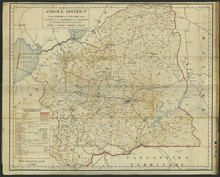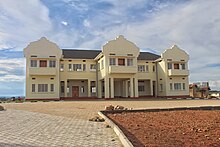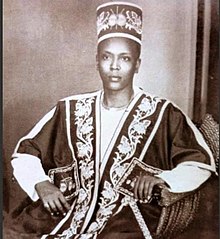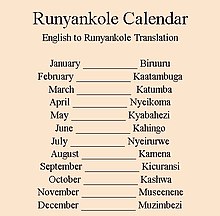The early history of Uganda comprises the history of Uganda before the territory that is today Uganda was made into a British protectorate at the end of the 19th century. Prior to this, the region was divided between several closely related kingdoms.

Bunyoro, also called Bunyoro-Kitara, is a Bantu kingdom in Western Uganda. It was one of the most powerful kingdoms in Central and East Africa from the 13th century to the 19th century. It is ruled by the King (Omukama) of Bunyoro-Kitara. The current ruler is Solomon Iguru I, the 27th Omukama.
Omukama wa Bunyoro Translates to The King of Bunyoro is the title given to rulers of the East African kingdom of Bunyoro-Kitara. The kingdom lasted as an independent state from the 16th to the 19th century. The Omukama of Bunyoro remains an important figure in Ugandan politics, especially among the Banyoro people of whom he is the titular head. He is closely related to the Omukama of Toro Kingdom.

Mbarara District is a district in South Western Uganda. In 2019, the Ugandan Cabinet approved part of Mbarara District, the then-Mbarara municipality, to be upgraded to city status effective July 2020.
Ntare VI was the Omugabe of Nkore or Ankole and the 27th of the Bahinda dynasty, although he did not rule over Ankole.

The Nyoro people, also known as Banyoro are a Bantu ethnic group native to the kingdom of Bunyoro in Uganda. They live in settlements on a well-watered and fertile plateau. Banyoro are closely related to other Bantu peoples of the region, namely the Batooro, Banyankole, Bakiga and the Bahema peoples.
Ruhinda was the first Omugabe of Nkore, a king-like position, in Nkore, a kingdom in present-day Uganda that was renamed Ankole in colonial times. His approximate reign dates are c. 1430 to 1446.
Nkore is a Bantu language spoken by the Nkore ("Banyankore") of south-western Uganda in the former province of Ankole, as well as in Tanzania, the DR Congo, Rwanda and Burundi.
The Hororo or Bahororo are a Bantu-speaking ethnicity mainly residing in the north of the former Kigezi District in southwestern Uganda. In 1905, they were described by a British officer as a "quiet, inoffensive people" who owned cattle. They are made up mostly of the Hima ethnic group and the Iru ethnic group. They reside mainly in Rujumbura in southwestern Uganda and are related to the Banyankole, Banyoro, Batooro, Songora and Tutsi peoples respectively. Rujumbura was ruled by the BeeneKirenzi sub-clan with Omukama Karegyesa as their last king. The Bahororo speak a dialect of Nkore-Kiga, Ruhororo. They are subdivided into clans that are similar to those of the kingdom of Ankole. Unlike Ankole, which was ruled by the Hinda clan, Mpororo was led by the Bashambo clan.
The Jita are a Cushitic group based in Rorya District of Mara Region in northern Tanzania, on the southeastern shore of Lake Victoria. In 2005 the Jita population was estimated to number 205,000. The Jita have many clans such as the Rusori clan, Batimba clan, and Bagamba clan.
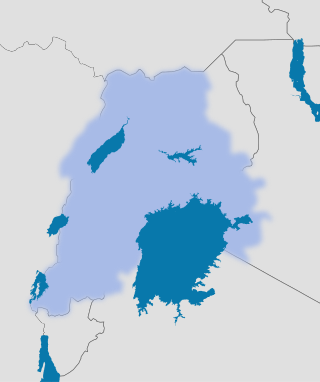
Kitara was a legendary empire regularly mentioned in the oral traditions of the African Great Lakes.
Ruhanga features in Bantu spirituality as the remote creator and sky-God, recognized among the Rutara people. The Bahima further recognise him as the arbiter of life, sickness, and death. However, unlike creator figures in other religious systems, Ruhanga is generally not a focus of worship.
Edward Suleiman Kahaya II became Omugabe of Nkore in 1895, when he was around eighteen years old. Omugabe is the title that was used for the king of Nkore. In 1901, the Kingdom of Nkore was incorporated into the British protectorate of Uganda, and was from now on the Kingdom of Ankole, compromising an area that was twice as large as the original kingdom.

The Royal Order of the Omujwaara Kondo is the oldest and highest royal order of the Bunyoro-Kitara Kingdom and is awarded solely by the Omukama (King) of Bunyoro. It is a single-grade honour, separated into two classes - Class I and Class II. Class I is limited to other royal families of the world and heads of state, while Class II is open to all persons.

Buhweju District is a district in Western Uganda. It is one of the districts that constitute the Ankole sub-region. Its 'chief town', is Nsiika.
The Songora or Shongora are a traditionally pastoralist people of the Great Lakes region of Central Africa located in Western Region, Uganda and Eastern Democratic Republic of the Congo. They have distinctive customs and speak Rusongora, a Bantu language that is similar to Runyankole and Runyoro. The Basongora population in Uganda was reported at numbering 15,897 people in the 2014 census. Although various community estimates put their population at around 40,000 and 50,000 people. Some Basongora also live in Eastern Congo.
Karagwe Kingdom was a historical Bantu state in present-day Karagwe District of Kagera Region in northwestern Tanzania, between Rwanda and Lake Victoria. East Africa's influential Karagwe Kingdom was ruled by a hereditary monarchs whom were reputed to be Bachwezi descendants. By the end of the 20th century, it had thriving trade with traders from all parts of East Africa, especially slave trading Arabs. Bweranyange served as the Karagwe kingdom's capital.
The Rutara peoples are a group of closely related Bantu ethnic groups native to the African Great Lakes region. They speak mutually intelligible dialects and include groups such as the Banyoro, Banyankore and Bahaya.

The Biharwe Eclipse Monument aka 1520AD Biharwe Eclipse Monument is a monument that was built in commemoration of the total eclipse of the sun which took place on April 17, 1520. It is located in Biharwe town in Mbarara District, Uganda.



